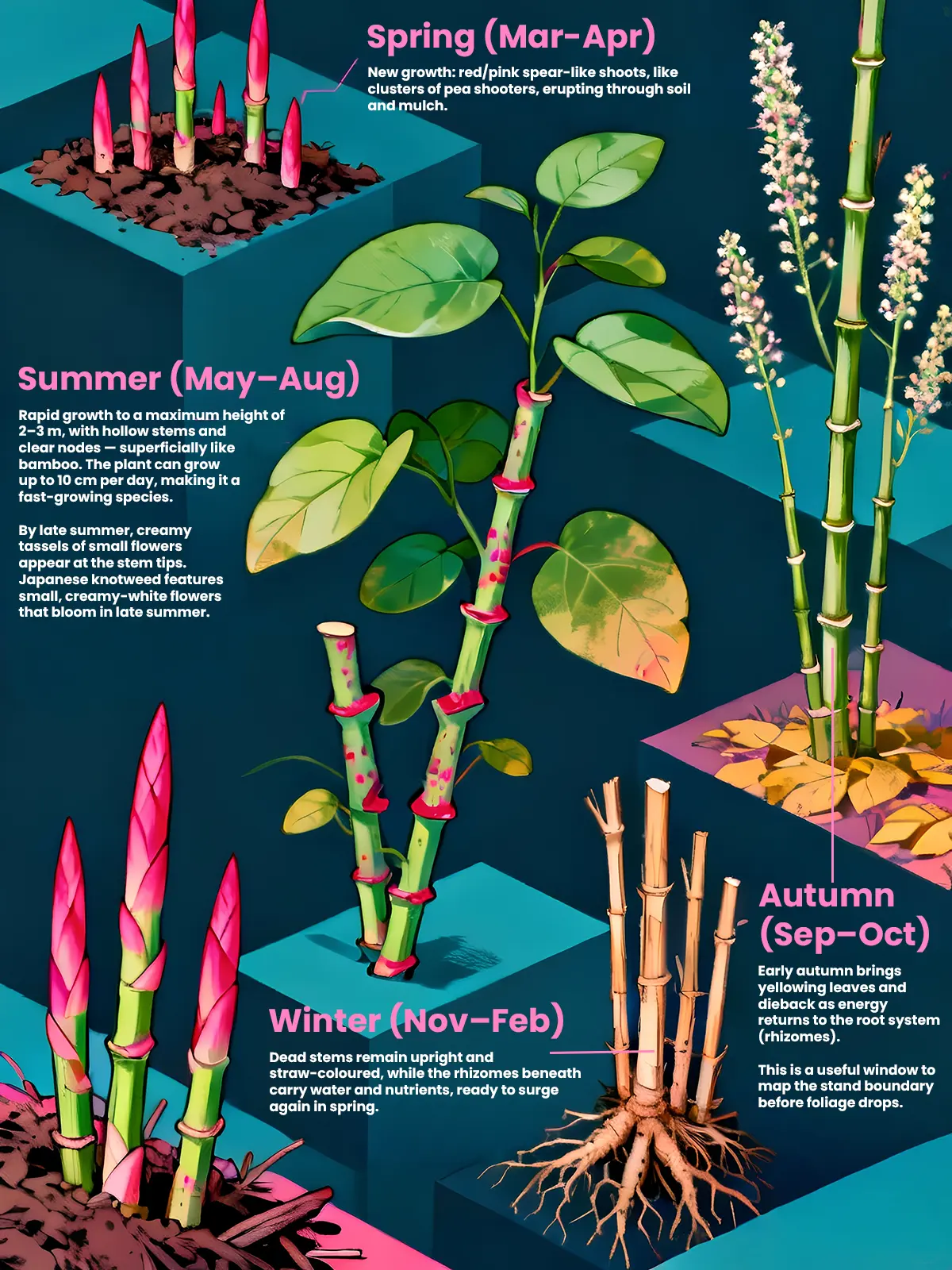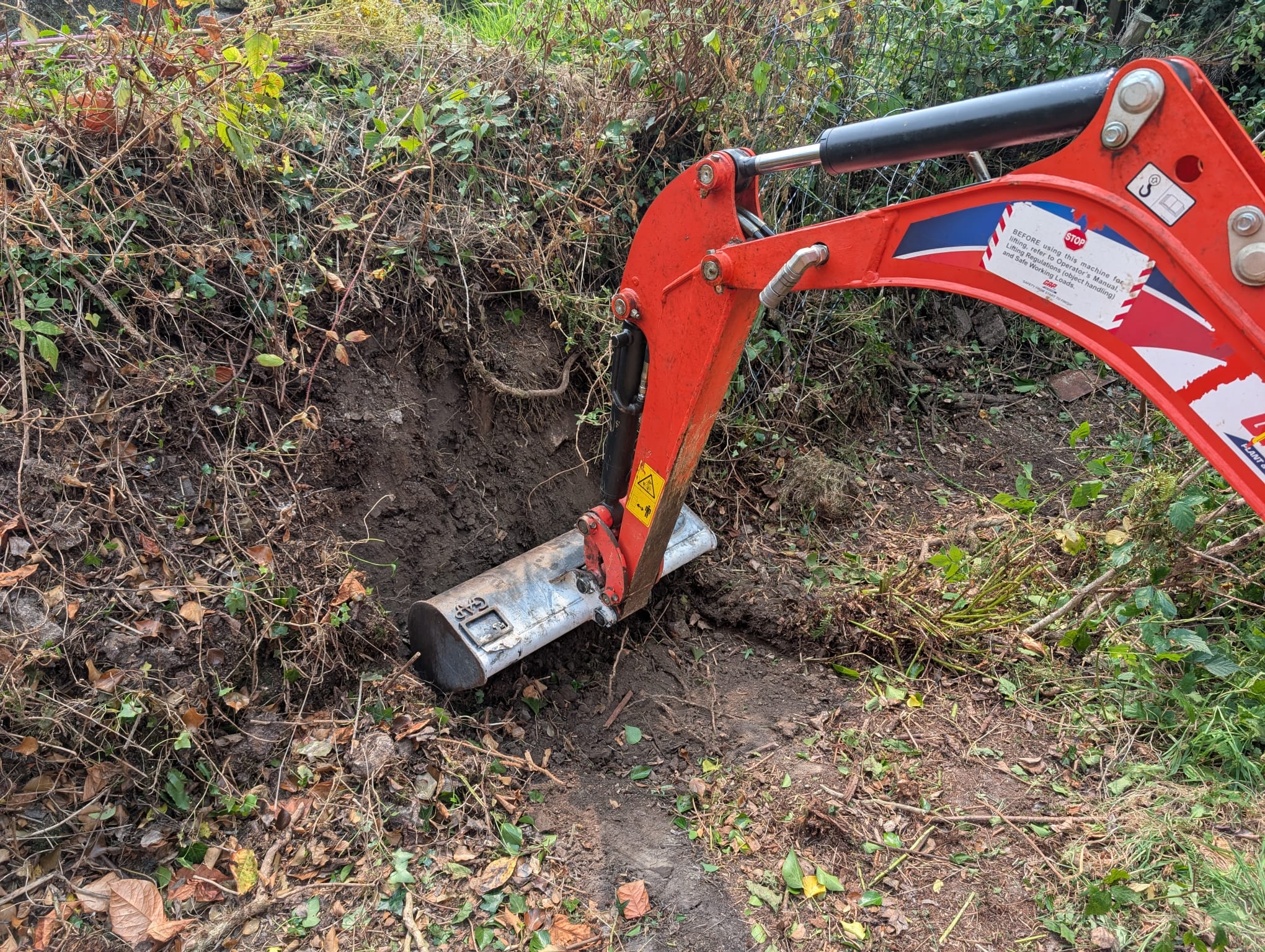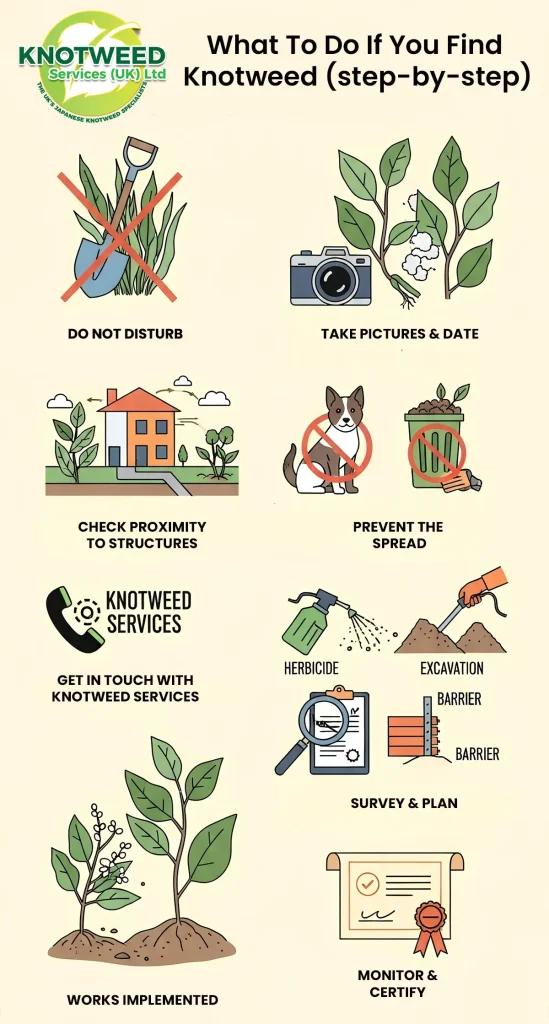Your Essential Japanese Knotweed Guide
Your definitive UK guide from Knotweed Services — identification, risks, UK law, treatment options, costs, and exactly what to do next.
Quick Facts (At a Glance)
- Latin name: Fallopia japonica (syn. Reynoutria japonica, also known as Polygonum cuspidatum in some botanical and medicinal contexts)
- Origin: Eastern Asia (Japan and China), where it is also significant in Chinese traditional medicine and known as ‘huzhang’; introduced to Europe and the UK in the 1800s. The introduction of Japanese knotweed to the UK occurred in the 1850s as an ornamental plant.
- Spreads by: Rhizomes (underground stems) and viable fragments; seeds are far less significant in the UK
- Growth rate: Up to 10 cm per day in peak growing season
- Peak/maximum height: Typically 2–3 m by late summer
- Main risks: Structural issues to hard surfaces and retaining walls, lender and buyer concerns, disputes with neighbouring gardens
- Status in the UK: Controlled invasive species; strict rules for controlled waste handling and disposal
- Best time to act: Now — year-round options exist; plans typically run 2–4 seasons depending on method
What is Japanese knotweed?
Japanese knotweed (Fallopia japonica) is a fast growing perennial in the Polygonaceae family. Native to volcanic mountains in Japan and parts of China, it was brought to Europe as an ornamental and then to North America where it spread along railways and rivers.
The plant forms thickets that cause problems for property owners and local authorities as it grows in gardens, on brownfield ground, and around infrastructure by exploiting weaknesses in hard surfaces including paving, pipe runs and retaining walls. It’s often called bamboo, American bamboo or Mexican bamboo in older texts (and even donkey rhubarb in British slang), but it’s only related to those species by appearance not taxonomy.
You may also see it listed as Polygonum cuspidatum (TCM ‘huzhang’).
As an invasive plant Japanese knotweed’s underground root system (rhizomes and roots) stores energy to fuel rapid growth, so when stems are cut or soil is disturbed it can re-sprout. It’s notorious for spreading through rhizome fragments and stem pieces, so control of this invasive plant is hard.
Rhizomes of Japanese knotweed can remain dormant and viable for many years, making eradication a challenge. Rhizomes can survive extreme temperatures and can go horizontal and vertical, so removal is tough. That’s why fragment movement – not seeds – is the main way it spreads in the UK.
How to identify it (seasonal guide + lookalikes)
Spring (Mar–Apr)
- New growth: red/pink spear-like shoots, like clusters of pea shooters, erupting through soil and mulch.
- These quickly form hollow, green stems with reddish flecks, arranged in a zig-zag.
- Leaves: fresh green, broad oval with a truncated base and entire margin.
Summer (May–Aug)
- Rapid growth to a maximum height of 2–3 m, with hollow stems and clear nodes — superficially like bamboo.
- The plant can grow up to 10 cm per day, making it a fast-growing species.
- By late summer, creamy tassels of small flowers appear at the stem tips. Japanese knotweed features small, creamy-white flowers that bloom in late summer. These flowers provide an important source of nectar for honeybees.
Autumn (Sep–Oct)
- Early autumn brings yellowing leaves and dieback as energy returns to the root system (rhizomes).
- This is a useful window to map the stand boundary before foliage drops.
Winter (Nov–Feb)
Dead stems remain upright and straw-coloured, while the rhizomes beneath carry water and nutrients, ready to surge again in spring.
Common lookalikes (and how to tell them apart):
- Giant knotweed (Fallopia sachalinensis): taller with much larger leaves; closely related and also invasive.
- Hybrid knotweed (Fallopia × bohemica): intermediate traits between Japanese and giant.
- Himalayan fleece vine (Fallopia baldschuanica): rampant climber with frothy flowers — often mistaken due to the name and bamboo-like nodes.
- Russian vine: another vigorous climber with similar panicles, but leaf shape and habit differ.
- Himalayan honeysuckle (Leycesteria formosa): upright shrub with berries; again, very different flowers.
- Other plants with cane-like stems (e.g., true bamboo) may confuse at a glance; check the truncated base on leaves and the zig-zag arrangement.
Tip: Photograph the stems and leaf base, plus any flowers, and we’ll confirm ID. If repeatedly cut or strimmed, smaller plants can look different — but those pea shooters in spring are a giveaway.

Why it matters: property, legal and environmental impact
- Property & infrastructure: Rhizomes probe cracks and joints in hard surfaces and retaining walls making existing defects worse. On architectural sites (old foundations, embankments, culverts) knotweed can complicate works and warranties. Japanese knotweed has a strong and extensive root system that can get through the cracks of hard surfaces like concrete, asphalt and brick.
- Neighbour relations: Where stands straddle boundaries, neighbouring gardens often argue about who is responsible and when and how to control.
- Transactions & lending: Surveyors flag up visible stands or historical removal attempts. Lenders ask for a professional management plan with a guarantee before they will progress.
- Ecology & biodiversity: Invasive species that form monocultures suppress native plants and alter wildlife habitat. Japanese knotweed invades a wide range of habitats, riverbanks, roadsides and waste ground, outcompeting native species. In the UK it’s a problem because of its impact on biodiversity and property. The World Conservation Union has highlighted the impact of knotweed on riverbanks and riparian systems in Europe and beyond.
See how prolific Japanese Knotweed is in your area: Japanese knotweed postcode map.
UK law & compliance (plain-English)
- Under the Wildlife and Countryside Act, it’s an offence to cause Japanese knotweed to grow in the wild.
- Soil or plant material containing knotweed is controlled waste; transport and disposal must follow licensed protocols.
- Construction and remediation programmes should include method statements for control, soil handling and verification.
- Selling a property? Disclose accurately and provide documentation of the control plan and any insurance-backed guarantee (IBG).
Bottom line: Don’t dig, strim or relocate contaminated ground. Document the issue and speak to a specialist.
Click here for more information on Japanese Knotweed and the law.

Treatment & removal options (with pros, cons, timelines, costs)
1) Herbicide Treatment Plan (HTP)
What it is: Timed, selective applications over multiple seasons to exhaust the rhizome root system. This involves applying herbicides at specific times during the growing season when the plant is most vulnerable, so the chemicals can be translocated down to the underground rhizomes. Over successive treatments the energy reserves in the rhizomes are depleted, the plant can’t regenerate. This requires careful planning and monitoring to ensure applications are effective and minimal environmental impact.
Pros: Cost effective, minimal disruption, suitable for gardens where development isn’t imminent.
Cons: Requires patience (2-4 seasons); regrowth can occur if stands are cut at the wrong time.
Indicative cost: From £1,500-£8,500+ (site specific).
More Info
- Herbicide Vs Excavation – Pros and Cons/cost analysis
- Click –> to find out more about Japanese Knotweed Excavation
2) Excavation & Off-Site Disposal
What it is: Controlled excavation of rhizome-contaminated soils with licensed haulage. We dig out the soil with the Japanese knotweed rhizomes and haul it to licensed disposal sites to prevent the spread of this invasive species. Due to the plant’s extensive root system, excavation has to be thorough to ensure all rhizome fragments are removed, as even small pieces left behind will regrow. Licensed haulage ensures the contaminated soil is handled in accordance with environmental regulations to prevent spread to new areas. This is often chosen when rapid removal is required, e.g. before construction or sale, but requires strict compliance with controlled waste management regulations.
Pros: Quick risk reduction for sales or construction.
Cons: More expensive; controlled waste; strict tracking to avoid spreading in the wild.
3) On-Site Burial/Capping with Root Barrier
What it is: Encapsulate to designed depth; install barriers around utilities and walls. This method involves isolating the contaminated soil and plant material by covering it with impermeable membranes or root barriers to prevent rhizome growth beyond the treated area. The barriers are carefully installed to protect critical infrastructure such as underground utilities and walls from damage caused by knotweed roots. Encapsulation is good for larger sites where full excavation is not practical, so the plant material can be contained safely and prevent further spread. Proper installation and maintenance of these barriers is key to long term effectiveness and the area should be monitored regularly for any signs of breakthrough growth.
Pros: No disposal costs; good for larger building sites.
Cons: Needs space and as-built records to protect future works.
4) Screening/Sifting with Targeted Removal
What it is: Mechanical processing to reduce waste volume, with spot treatment. This involves physically breaking down excavated soil and plant material contaminated with Japanese knotweed to reduce the amount of waste that needs to be disposed of. By reducing the volume it reduces the cost of disposal and makes it more manageable. After mechanical processing targeted spot treatments such as herbicide application or manual removal are used to treat any remaining knotweed fragments and prevent regrowth. This is useful on development sites with mixed soil types where full excavation and removal may not be possible. But requires strict protocols to ensure knotweed fragments are not spread during processing and follow up inspections to monitor for regrowth.
Pros: Useful on development plots with mixed soil.
Cons: Needs strict protocols and follow up inspections.
5) Post-Treatment Monitoring & Guarantees
What it is: Inspections, photos and remedial work as required. These inspections are usually done at regular intervals throughout the treatment period to monitor progress and results. Photos provide a clear and verifiable record of the plant’s condition over time, especially important for property sales and lender requirements. Remedial work may include additional herbicide applications, manual removal of regrowth or adjustments to the treatment plan based on results. Ongoing monitoring means any Japanese knotweed resurgence is dealt with quickly, reducing the risk of spread and increasing the chances of success.
Pros: Provides the audit trail lenders expect. IBGs typically 5–10 years.
Note: Plans should map barrier lines, utilities and any retaining walls to prevent accidental breach.
Which route is right? It depends on your objective (sell, develop, restore a garden), programme and budget. We’ll tailor a plan that balances speed with long-term certainty.
Find out more: formal Japanese Knotweed Management Plan with insurance-backed guarantee.
Field ID checklist (for survey notes)
This is a simple Field ID checklist for Japanese knotweed. Tick off the key identification points (leaves, stems, flowers, seasonality and confusers), add notes, and then copy or print your record. Your progress saves in your browser so you can return to it during a site survey.

